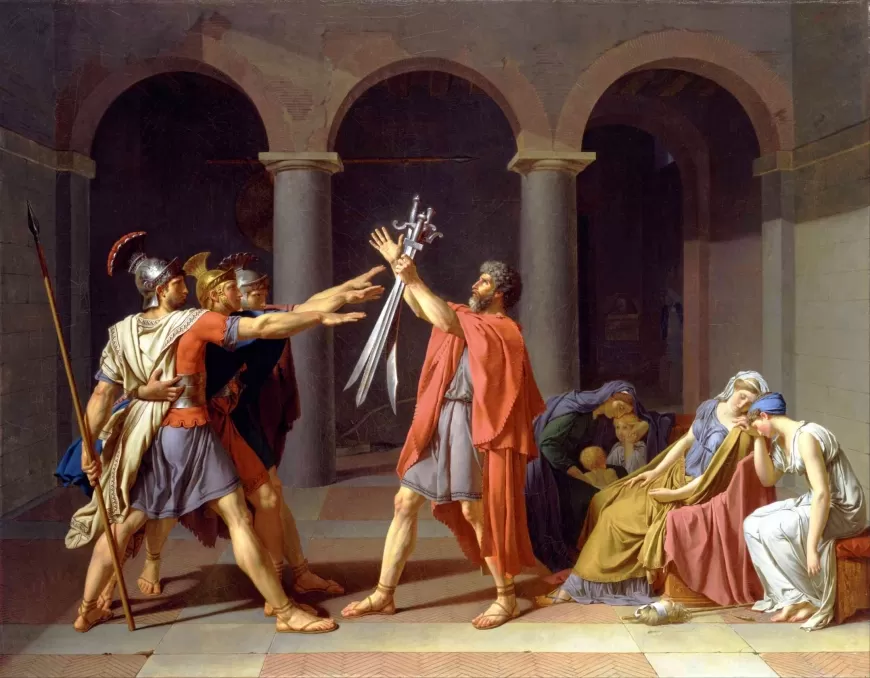What Was the Real Roman Salute? Separating Fact from Fiction
The "Roman salute" as popularly depicted—with an extended arm—is a modern myth, originating in 18th-century art and politicized in the 20th century. Ancient Romans used various gestures like the "Ave" greeting, dextrarum iunctio (clasping of right hands), and raising the hand to signify peace, respect, and loyalty. Learn the truth about Roman customs and separate historical fact from cultural fiction.

What is the actual Roman Salute?
The "Roman salute" is often shown in the media and popular culture as an action whereby an individual raises one's arm outward, palm down, stiff and formal. In history, however, this is not how things were. It is rather more of a 20th-century myth than a representation of the actual Roman tradition. So let us take a look at its origins and what really was the Roman salute.
The Misconception of the Roman Salute
The modern concept of the Roman salute gained popularity in the 19th and early 20th centuries, especially through artistic depictions and nationalist propaganda. The salute was popularized by Italian fascists and later adopted by the Nazis. However, there is little to no evidence of such a gesture being used in ancient Rome.
This misconception probably had its roots in neoclassical art from the 18th century. Painters, for example, Jacques-Louis David in his famous work The Oath of the Horatii, used the same gesture to depict Roman figures. This artistic expression was then confused with history and passed down through popular culture.
What Did the Real Roman Salute Look Like?

In fact, the ancient Romans probably did not have a salutation that was standardised in any way like that popularized in the 20th century. Rather, gestures of respect and greeting were more personal and varied, often involving:
- Raising a Hand in Greeting: A friendly wave or the raising of an open hand may have been a common gesture to signify peace and goodwill.
- The Dextrarum Iunctio (Joining of Hands): This is a symbolic clasp of the right hands which was used mainly in formal alliances, agreements or to show union and loyalty.
- Nods or Verbal Greetings: A simple greeting like "Salve" meaning hello or "Ave" meaning hail coupled with a nod was a general Roman greeting.
What Is the Roman Greeting Gesture?
The Romans had a number of gestures that were used for greeting, respect, and loyalty. The most important are as follows:
1. The "Ave" Greeting
One of the most well-known Roman greetings was verbal. It used the word "Ave," which is Latin for "hail" or "be well." Often, it was accompanied by a respectful nod or bow of the head. Soldiers and citizens could use "Ave Caesar" to greet the emperor, showing loyalty and reverence.
2. Dextrarum Iunctio (The Clasping of Right Hands)
A handshake, or dextrarum iunctio, was another powerful symbol for the Romans. It meant a sign of trust, friendship, and mutual understanding, which it was used while participating in ceremonies or negotiations. Such an act meant a very strong gesture of brotherhood and reverence.
3. Raising the Right Hand
A more casual greeting gesture might include raising the right hand as an acknowledgment. This was a common peace gesture meant to indicate that the greeter was not carrying any weapon and approached with peaceful intentions.
4. Military Gestures
In the military, soldiers may carry out stiffened movements to show deference to their commanding officers or the emperor. However, such were more likely stylized poses or gestures rather than the "Roman salute" as pictured today.
Conclusion
The "Roman salute" as depicted in modern times is more of a myth than a historical reality. Ancient Romans used a variety of gestures, including verbal greetings, handshakes, and symbolic nods, to convey respect and camaraderie. The idea of the extended arm salute has its roots in artistic interpretations and was later adopted as a political symbol in the 20th century.
Understanding the true Roman greeting customs separates fact from fiction and provides a more accurate glimpse into the lives of the people of ancient Rome.
What's Your Reaction?


























































